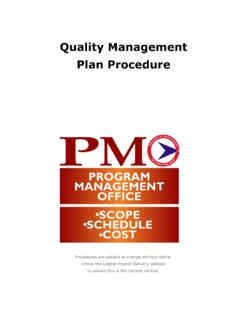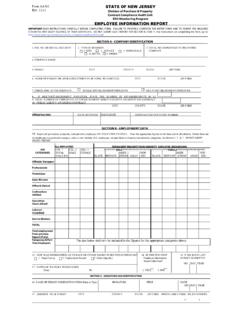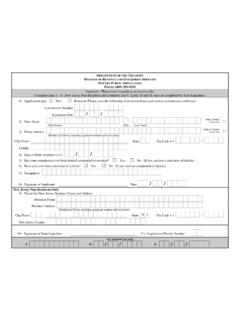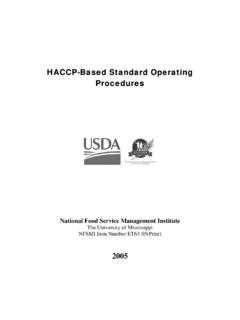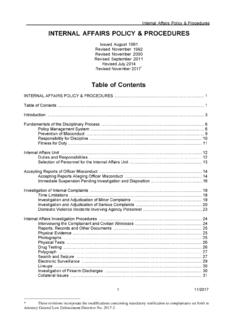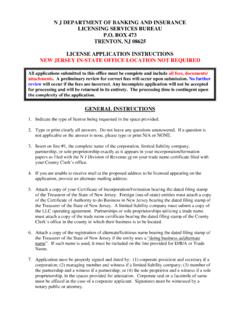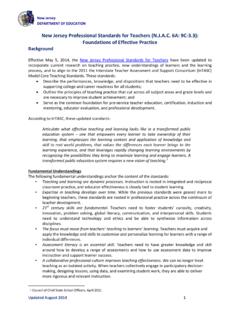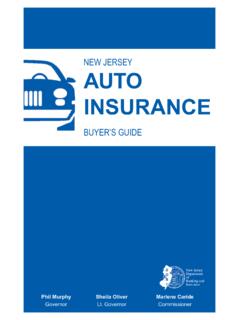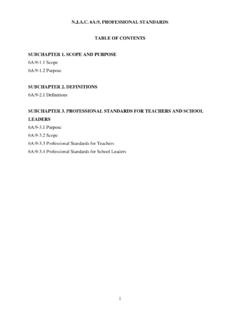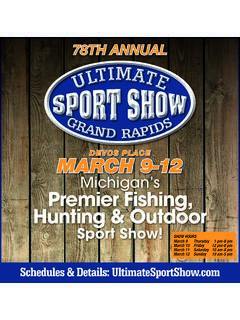Transcription of Boating Safety Manual - State
1 New Jersey State Police Boating Safety Manual HONOR. Y. S. LIT. DU. A B. TY. E. FID. N L. A. LIGHTS REQUIRED ON BOATS BETWEEN SUNSET AND MARINE RADIO INFORMATION. SUNRISE AND AT ALL TIMES OF RESTRICTED VISIBILITY. Boaters seeking information or emergency assistance, Figure 1 Figure 2 Figure 3. contact: New Jersey State Police Marine Law Enforcement or A (Closest station to your position). or B. B. Call Channel or Inland Only Channel 16, VHF Marine Band, Emergency Channel A B A. *Cell phones can also be very useful, however, other boaters Figure 4 Figure 5 Figure 6 in the area will not be able to hear your call for help. Keep in Great Lakes mind that you will lose reception quickly when on the water. ONLY. Call 911 or one of the Marine Law Enforcement stations from the phone list on page 46. or or B. or A A B A B Boating Safety EDUCATIONAL PROGRAM. The New Jersey State Police Marine Services Bureau Figure 8.
2 Conducts safe Boating programs annually. These programs are presented in schools during the winter months throughout the State . This program is free to those schools requesting this service. For this and other presentation requests, contact: New Jersey State Police Marine Services Bureau RANGE AND DEGREE OF VISIBILITY OF LIGHTS PO Box 7068. Inland and International West Trenton, NJ 08628-0068. Location Visible Range Degrees 609-882-2000, ext. 6173. (In Nautical Miles). Masthead light 2/3 225/225. All-around light 2/2 360/360. or Side lights 1/2 Stern light 2/2 135/135. 47. Table of Contents NEW JERSEY SAFE Boating .. 1. Boating Safety Education & Minimum Age Non-Tidal Boat License ..4. Navigation CHAPTER 1. Registration, Titling & Documentation .. 7. Boat Registration ..7. Registration Required ..7. Documented Vessels ..8. Numbering System & Display ..9. Validation Obtaining Applications.
3 10. Change of 11. Vessel 11. CHAPTER 2. Equipment .. 12. Muffling Device ..12. Coast Guard Approved Equipment ..12. Flame Arresters (Backfire Flame Control)..12. Sound Signaling Appliances For Vessels Less Than 20 Meters (65'6 )..13. Personal Flotation Devices ..13. Wearing of PFDs by Children 12 and Under ..15. Fire Extinguishers ..16. Marine Sanitation Devices (MSDs) ..17. Visual Distress Signals: The Regulations ..18. Visual Distress Signals: Handling and Visual Distress Signals Types ..20. Visual Distress Minimum Required Equipment by Length of Boat ..22. Meter-feet Rev. 02/06. CHAPTER 3. Operator's 27. Power-Driven Vessels ..27. International ..27. Inland ..27. Sailing Vessels & Vessels Under Oars ..28. International ..28. Inland ..29. Lights Used When Anchored ..29. International ..29. Inland ..29. Found Boating Accidents/Duties In Case of Accidents ..30.
4 Operating a Vessel Under the Influence of Intoxicating Liquor, Drugs or Narcotics ..32. Reckless or Careless Operation Forbidden ..35. Personal Watercraft ..35. Waterskiing ..36. Skin Diving ..38. Watercraft Noise Control ..38. Racing ..39. Race Test Loading Your Boat ..41. Water Pollution and the Recreational Discharge of Oil Prohibited ..41. CHAPTER 4. For Your 42. Security Afloat ..42. Report Stolen Boats and Equipment ..44. Bargain Float Plan ..44. Marine Law Enforcement Stations ..46. Marine Radio Information ..47. Boating Safety Education Equipment BACK COVER. NEW JERSEY SAFE Boating . The objective of the Boating Safety program is to reduce the risk of loss of life, injury and property damage associated with the use of recreational boats, and to provide the boaters with the maximum safe use of the State 's waterways. The State recognizes the need for safe Boating and highly recommends that the Boating enthusiasts make themselves thoroughly familiar with all of the laws, regulations and other information contained in this booklet.
5 Boating is best enjoyed when the boater is knowledgeable and diligent in observing Safety precautions. Rules and regulations quoted herein are most commonly used. New Jersey has adopted the Navigational Rules Internation- al-Inland and the Code of Federal Regulations as the stan- dards for vessel equipment and operation. The Navigational Rules and the Code of Federal Regulations can be purchased either at a boat supply store or through a Boating catalog. In addition to these standards, other laws, rules, and regulations have been adopted for the waters of this State . Consult local authorities for information on local ordinanc- es. 1. Boating Safety EDUCATION. & MINIMUM AGE MANDATORY REQUIREMENTS. Are you 16 years old or older? No Yes Have you completed an approved Boating Safety Course? No You cannot operate any power vessel on New Jersey waters. Were you born in 1979 or later?
6 *. Yes No You may operate any power vessel EXCEPT a personal watercraft. To You must complete a operate a personal Boating Safety course watercraft, you must have prior to operating ANY completed a Boating power vessel & have a Safety course and have a Boating Safety certificate. Boating Safety certificate. *Schedule for Completion of Mandatory Boating Safety Course: Persons born in 1969 or later must possess a Boating Safety Certificate by June 1, 2006. Persons born in 1959 or later must possess a Boating Safety Certificate by June 1, 2007. Persons born in 1949 or later must possess a Boating Safety Certificate by June 1, 2008. All persons who wish to operate a power vessel must possess a Boating Safety Certificate by June 1, 2009. 2. Boating Safety EDUCATION. & MINIMUM AGE MANDATORY REQUIREMENTS. For Those Under 16. Are you 13 years old or older? Yes No Have you completed an approved Boating Safety Course?
7 No Yes You cannot operate any power vessel on New Jersey waters. You may operate a vessel powered solely by an electric motor or a vessel 12 feet long or longer with less than 10 HP. 1) There are NO EXEMPTIONS to New Jersey age re- quirements. 2) Out-of- State residents in New Jersey for less than 90. days with a certificate issued by their State or country;. OR written proof of completion of a substantially similar course to the NJ-approved course will satisfy the educa- tion requirements. Boating Safety Course information may be located at: Boating Safety Courses must be completed in person. 3. NON-TIDAL BOAT LICENSE. Are you going to boat on Yes non-tidal water (Water where the tide does not change)? No No Non-Tidal Boat Does one of the below Yes License required. listed exemptions apply? No Non-tidal boat license required. Exemptions 1) Vessel powered by a motor less than 1 HP or a 12 volt electric motor.
8 2) A vessel 12 feet long or longer with less than 10 HP. 3) While competing in an authorized race pursuant to a per- mit issued by the Division of State Police in the Depart- ment of Law & Public Safety . 4) If the person is an out-of- State resident who has writ- ten proof of successful completion of a course substantially similar to a NJ approved Boating Safety Course. A boat license is separate from the Boating Safety certificate and is issued by the Motor Vehicle Commission (MVC). 4. NAVIGATION RULES. All vessels operating on the waters of this State are respon- sible for adherence to the Navigation Rules International/. Inland. The rules as defined in COMDTINST , are ap- plied as set forth under the COLREGS Demarcation Lines. In addition, all vessels 12 meters (39'4 ) and over in length are required to have on board a copy of the Navigation Rules, International/Inland, COMDTINST M , while operating on the waters of this State .
9 Rule 5, LOOKOUT. Every vessel shall at all times maintain a proper look-out by sight and hearing as well as by all available means ap- propriate in the prevailing circumstances and conditions so as to make a full appraisal of the situation and of the risk of collision. Rule 6, SAFE SPEED. Every vessel shall at all times proceed at a safe speed so that it can take proper and effective action to avoid collision and be stopped within a distance appropriate to the prevailing circumstances and conditions. Rule 7, COLLISION. Every vessel shall use all available means appropriate to the prevailing circumstances and conditions to determine if risk of collision exists. If there is any doubt such risk shall be deemed to exist. Rule 8, ACTION TO AVOID COLLISION. Any action taken to avoid collision shall, if the circumstanc- es of the case admit, be positive, made in ample time and 5.
10 With due regard to the observance of good seamanship. If necessary to avoid collision or allow more time to assess the situation, a vessel shall slacken its speed or take all way off by stopping or reversing its means of propulsion. Rule 9, NARROW CHANNELS. A vessel proceeding along the course of a narrow channel or fairway shall keep as near to the outer limit of the chan- nel or fairway which lies on its starboard side as is safe and practicable. Rule 14, HEAD-ON SITUATION. When two power-driven vessels are meeting on reciprocal or nearly reciprocal courses so as to involve risk of collision, each shall alter its course to starboard so that each shall pass on the port side of the other. Rule 15, CROSSING SITUATION. When two power-driven vessels are crossing so as to in- volve risk of collision, the vessel which has the other on its starboard side shall keep out of the way and shall, if the circumstances of the case admit, avoid crossing ahead of the other vessel.
